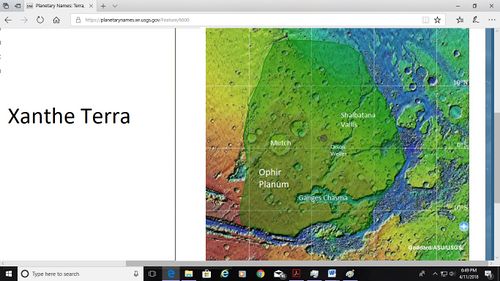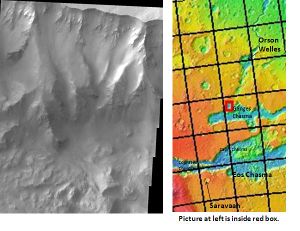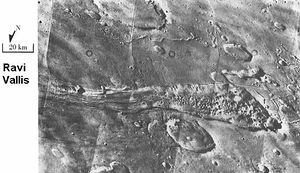Difference between revisions of "Xanthe Terra"
m |
|||
| (21 intermediate revisions by 3 users not shown) | |||
| Line 1: | Line 1: | ||
| + | {{Mars atlas}} | ||
| + | [[File: Wikiarabiaboundaries.jpg|thumb|500px|left|MOLA map showing boundaries of Xanthe Terra and other regions]] | ||
| − | + | ||
| − | + | [[File:Xantheterra6.jpg|thumb|500px|center|Map of Xanthe Terra with some features labeled]] | |
| − | |||
[[Image:Chaos in Xanthe.jpg|right|thumb|150px|Landslide in Xanthe Terra]] | [[Image:Chaos in Xanthe.jpg|right|thumb|150px|Landslide in Xanthe Terra]] | ||
==Location== | ==Location== | ||
| − | Xanthe Terra is a large area on Mars, centered just north of the Martian equator. Its coordinates are 3 N and | + | Xanthe Terra is a large area on [[Mars]], centered just north of the Martian equator. Its coordinates are 3 N and 312 E (48 W), and its diameter is |
| − | 1867.65 km. | + | 1867.65 km.<ref>"Xanthe Terra". Gazetteer of Planetary Nomenclature. USGS Astrogeology Research Program.</ref> <ref>^ http://planetarynames.wr.usgs.gov</ref> Parts of Xanthe are in four different quadrangles: [[Lunae Palus quadrangle|Lunae Palus]], [[Coprates quadrangle|Coprates]], [[Margaritifer Sinus quadrangle|Margaritifer Sinus]], and [[Oxia Palus quadrangle|Oxia Palus]]. |
| − | Its name means "golden-yellow land." “Xanthe” comes from a Greek word meaning yellow. | + | Its name means "golden-yellow land." “Xanthe” comes from a Greek word meaning yellow.<ref>Funk and Wagnalls. Standard College Dictionary. 1963. Harcourt, Brace, World. NY.</ref> This word is found in other words such as xanthophyll, a plant pigment often seen in leaves in the fall. |
==Major features== | ==Major features== | ||
| − | Many interesting features are found in this small region including, Ravi Vallis, Aromatum Chaos, Ophir, Ganges Chasma, Nanedi Valles, Shalbatana Vallis, Orson Welles Crater, Mutch Crater, and Da Vinci. A Viking 1 orbiter picture of Ravi Vallis and Aromatum Chaos was highly suggestive that huge floods came out of the ground in chaos regions and formed large outflow channels. Orson Welles Crater was named after Orson Welles who did the 1938 radio broadcast of “The War of the Worlds.” Mutch Crater was named after Thomas Mutch who wrote “The Geology of Mars” in 1977. Mars Global Surveyor’s MOC found a 660 foot (200 m) wide channel on the floor of Nanedi Vallis that is thought to from a continued flow that caused new downcutting. | + | Many interesting features are found in this small region including, Ravi Vallis, Aromatum Chaos, Ophir, Ganges Chasma, Nanedi Valles, Shalbatana Vallis, Orson Welles Crater, Mutch Crater, and Da Vinci Crater. A Viking 1 orbiter picture of Ravi Vallis and Aromatum Chaos was highly suggestive that huge floods came out of the ground in chaos regions and formed large outflow channels. Orson Welles Crater was named after Orson Welles who did the 1938 radio broadcast of “The War of the Worlds.” Mutch Crater was named after Thomas Mutch who wrote “The Geology of Mars” in 1977. Mars Global Surveyor’s MOC found a 660 foot (200 m) wide channel on the floor of Nanedi Vallis that is thought to from a continued flow that caused new downcutting. |
| − | [[File:Ganges Chasma.jpg | + | [[File:Ganges Chasma.jpg|thumb|300px|left| File:Ganges Chasma]] |
<gallery> | <gallery> | ||
| − | + | Image:Nanedivalles.gif|Wide view of Nanedi Vallis, as seen by Viking Orbiter 1 | |
File:Nanedivallesmoc2.gif|Close view of Nanedi Vallis, as seen by the Mars Orbiter Camera (MOC) on Mars Global Surveyor Arrow shows small channel. | File:Nanedivallesmoc2.gif|Close view of Nanedi Vallis, as seen by the Mars Orbiter Camera (MOC) on Mars Global Surveyor Arrow shows small channel. | ||
</gallery> | </gallery> | ||
| Line 28: | Line 29: | ||
[[Image:Alluvial Fans in Mojave Crater.jpg|thumb|300px|left|Alluvial Fans in Mojave Crater, as seen by HiRISE. High ground is on the right. Branched network of channels runs from higher ground (crater rim) to lower ground. | [[Image:Alluvial Fans in Mojave Crater.jpg|thumb|300px|left|Alluvial Fans in Mojave Crater, as seen by HiRISE. High ground is on the right. Branched network of channels runs from higher ground (crater rim) to lower ground. | ||
]] | ]] | ||
| − | |||
| − | |||
| − | |||
| − | |||
==References== | ==References== | ||
{{Reflist}} | {{Reflist}} | ||
| + | |||
| + | [[Category: Topography]] | ||
Latest revision as of 12:42, 10 November 2020
Location
Xanthe Terra is a large area on Mars, centered just north of the Martian equator. Its coordinates are 3 N and 312 E (48 W), and its diameter is 1867.65 km.[1] [2] Parts of Xanthe are in four different quadrangles: Lunae Palus, Coprates, Margaritifer Sinus, and Oxia Palus.
Its name means "golden-yellow land." “Xanthe” comes from a Greek word meaning yellow.[3] This word is found in other words such as xanthophyll, a plant pigment often seen in leaves in the fall.
Major features
Many interesting features are found in this small region including, Ravi Vallis, Aromatum Chaos, Ophir, Ganges Chasma, Nanedi Valles, Shalbatana Vallis, Orson Welles Crater, Mutch Crater, and Da Vinci Crater. A Viking 1 orbiter picture of Ravi Vallis and Aromatum Chaos was highly suggestive that huge floods came out of the ground in chaos regions and formed large outflow channels. Orson Welles Crater was named after Orson Welles who did the 1938 radio broadcast of “The War of the Worlds.” Mutch Crater was named after Thomas Mutch who wrote “The Geology of Mars” in 1977. Mars Global Surveyor’s MOC found a 660 foot (200 m) wide channel on the floor of Nanedi Vallis that is thought to from a continued flow that caused new downcutting.
Images from Mars Express, Mars Global Surveyor, and the Mars Reconnaissance Orbiter have revealed ancient river valleys and deltas. The deltas show many thin layers just as deltas on Earth. Scientists speculate that features in Xanthe Terra show evidence of precipitation on early Mars.[4]
References
- ↑ "Xanthe Terra". Gazetteer of Planetary Nomenclature. USGS Astrogeology Research Program.
- ↑ ^ http://planetarynames.wr.usgs.gov
- ↑ Funk and Wagnalls. Standard College Dictionary. 1963. Harcourt, Brace, World. NY.
- ↑ http://www.spaceref.com/news/viewpr.html?pid=26527














